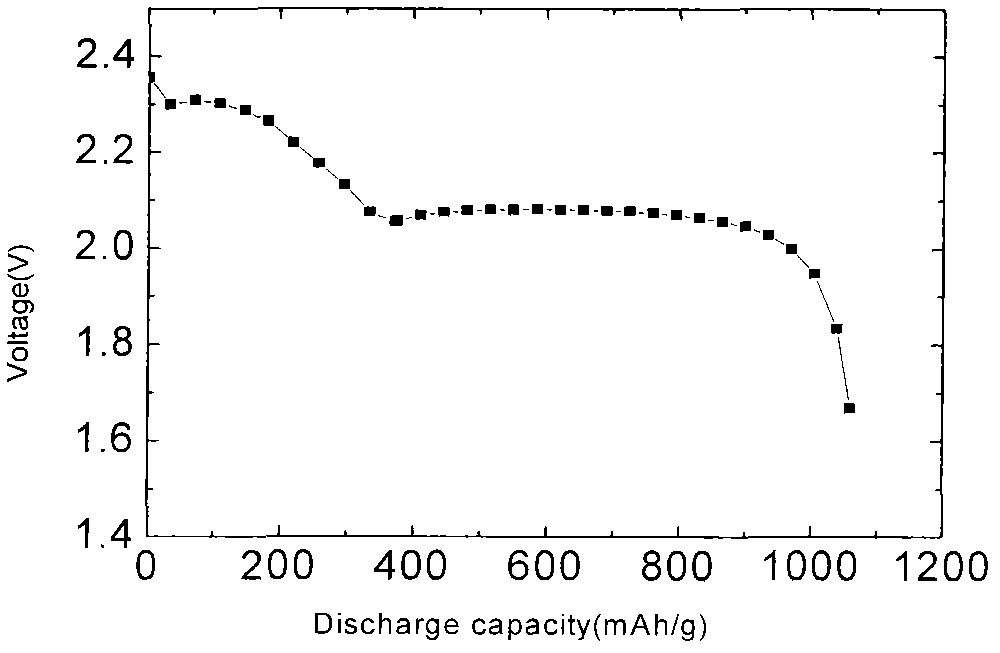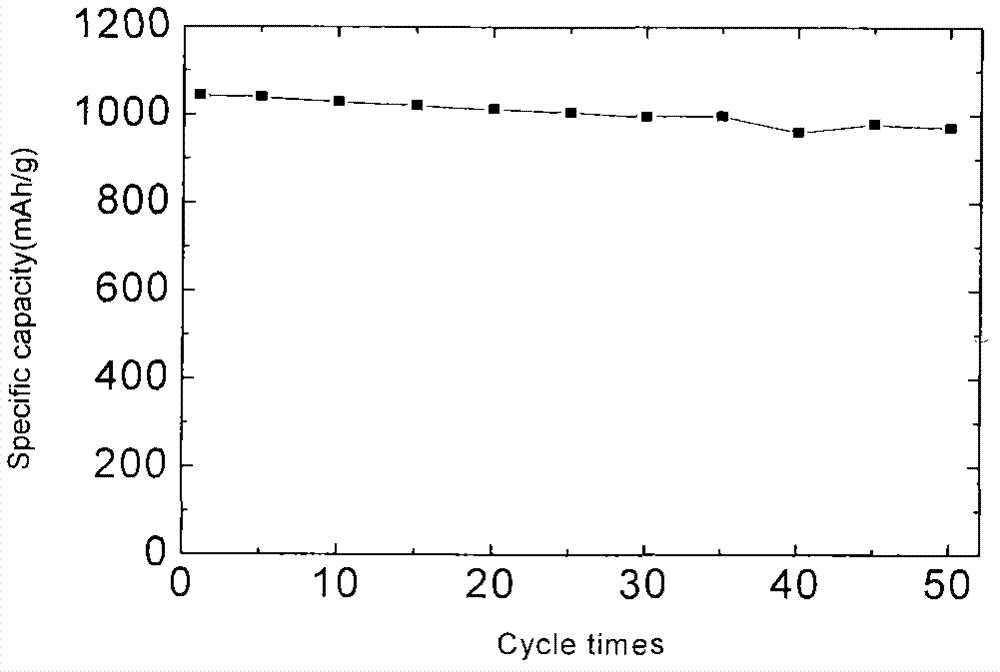Carbon/sulfur composite positive material having long cycle life, and preparation method thereof
A composite cathode material, carbon-sulfur composite technology, applied in battery electrodes, electrical components, circuits, etc., can solve the problems of unstable electrode structure, low discharge median voltage, low discharge specific capacity, etc. , Improve the effect of sulfur contact area and high discharge specific capacity
- Summary
- Abstract
- Description
- Claims
- Application Information
AI Technical Summary
Problems solved by technology
Method used
Image
Examples
example 1
[0032] Put 15g of multi-walled carbon nanofibers in a 1000ml three-neck round bottom flask filled with 600mL H 2 SO 4 / HNO 3 (volume ratio is 3: 1) in the mixed acid, ultrasonic 30min, water-bath heating and reflux 8h, vacuum suction filtration, wash repeatedly with deionized water until PH>5, put filtrate in vacuum oven and dry, obtain Oxidized carbon nanofibers. Then take 10g of oxidized nano-carbon fiber and add it to 250mL of acetone solvent, and disperse it with a high-speed disperser for 30 minutes; take another beaker, then add 20g of propylene oxide, 150mL of acetone, and disperse at a high speed for 10 minutes; mix the two together, and pour them into three round bottoms The flask was stirred and heated to 150°C, and the catalyst was added to react for 6 hours. The reactants were washed with dichloromethane, filtered, and the filtrate was dried in a vacuum oven to obtain grafted carbon nanofibers.
example 2
[0034] Prepare c(K 2 Cr 2 o 7 )=0.25mol / L, c(H + ) = 1mol / L mixed solution 500mL into a 1000mL three-neck flask, add 15g of multi-walled carbon nanofibers, ultrasonically disperse for 30min, stir mechanically at a high speed at 80°C for 4h, cool, and rinse repeatedly with a large amount of deionized water until the filtrate is neutral. Put the product in a vacuum drying oven at 80°C for 24 hours and then grind it.
[0035] Weigh a certain amount of oxidized nano-carbon fiber and N,N dihydroxyethyl-3-aminomethyl acrylate into a three-necked flask, add p-toluenesulfonic acid with a mass fraction of 1% as a catalyst, and ultrasonically disperse for 30 minutes after adding acetone. After stirring mechanically at 60°C to completely volatilize acetone, at a certain temperature and N 2 Stir mechanically under air protection for 4-12 hours. After the reaction is completed, the product is washed repeatedly with chloroform, centrifuged until no longer containing hyperbranched poly(...
example 3
[0037] Put 15g of multi-walled carbon nanofibers in a 1000ml three-neck round bottom flask filled with 600mL H 2 SO 4 / HNO 3(volume ratio is 3: 1) in the mixed acid, ultrasonic 30min, water-bath heating and reflux 8h, vacuum suction filtration, wash repeatedly with deionized water until PH>5, put filtrate in vacuum oven and dry, obtain Oxidized carbon nanofibers. Then take 10g of oxidized nano-carbon fiber and add it to 250mL of acetone solvent, and disperse it with a high-speed disperser for 30 minutes; take another beaker, then add 100g of methoxytetraethylene glycol, 150mL of acetone, and disperse it at a high speed for 30 minutes; mix the two together, pour into The three-neck round bottom flask was stirred and heated to 150°C, and the catalyst was added to react for 24 hours. The reactant was washed with acetone, filtered, extracted with reflux of acetone, dried in a vacuum oven at 60° C. for 12 hours, and ground to obtain grafted carbon nanofibers.
PUM
| Property | Measurement | Unit |
|---|---|---|
| diameter | aaaaa | aaaaa |
| electrical conductivity | aaaaa | aaaaa |
Abstract
Description
Claims
Application Information
 Login to View More
Login to View More - R&D
- Intellectual Property
- Life Sciences
- Materials
- Tech Scout
- Unparalleled Data Quality
- Higher Quality Content
- 60% Fewer Hallucinations
Browse by: Latest US Patents, China's latest patents, Technical Efficacy Thesaurus, Application Domain, Technology Topic, Popular Technical Reports.
© 2025 PatSnap. All rights reserved.Legal|Privacy policy|Modern Slavery Act Transparency Statement|Sitemap|About US| Contact US: help@patsnap.com


